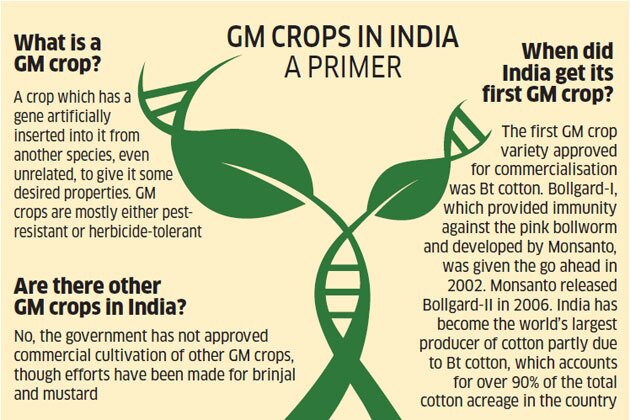Relevance: Prelims/Mains: G.S paper III: Agriculture: Genetically Modified Crops
WHY IN NEWS?
FSSAI issues order on 24 items even as it works on regulations for GM foods
From January 1, 2021, importers of 24 major food crops will have to mandatorily declare that the products are not genetically-modified and that they also have a non-GM origin.
The Food Safety and Standards Authority of India (FSSAI) has come out with this order to ensure that only non-GM food crops come into the country.
ANALYSIS
Genetically modified crops (GM crops) are plants used in agriculture, the DNA of which has been modified using genetic engineering techniques. More than 10% of the world’s croplands are planted with GM crops.
In most cases, the aim is to introduce a new trait to the plant which does not occur naturally in the species like resistance to certain pests, diseases, environmental conditions, herbicides etc.
Genetic Modification is also done to increase nutritional value, bioremediation and for other purposes like production of pharmaceutical agents, biofuels etc.

Concerns regarding Genetically Modified Crops
Many believe that food on the market derived from GM crops poses no greater risk to human health than conventional food. However, opponents have objected to GM crops on several grounds, including environmental concerns, the safety of GM foods, the business interests behind GM crops, intellectual property laws etc.

Arguments in favour of GM Crops:
The proponents, argue that the GM technologies have been around for about 15 years and they have been in use across the world including in countries such as Brazil and China. During a visit to India in March 2005, Norman Borlaug – widely regarded as the father of the Green Revolution – supported producing genetically modified (GM) food to eradicate hunger from the world. “It is better to die eating GM food instead of dying of hunger,” said the Nobel laureate, who passed away in 2009.
- Former prime minister, Manmohan Singh, saw biotechnology as key to food security and warned against succumbing to “unscientific prejudices”.
- “The concerns over their (GM crops) perceived risks should be addressed by following internationally accepted procedures for assessing safety parameters. ICAR, which is involved in developing useful products and technologies in this field, must contribute to the public discourse and provide clarity on this sensitive issue,” – President Pranab Mukerjee.
- Indian intelligence agency names anti-GM groups such as Greenpeace India and Gene Campaign as one of the many “anti-national” foreign-funded NGOs hampering India’s economic progress.
- Agriculture scientists from research institutions including IARI, ICAR and various Universities demanding “field trials” for GM crops, arguing that “confined field trials are essential for the evaluation of productivity performance as well as food and environmental safety assessment”.
- A group of prominent scientists had met under ‘father of green revolution’ MS Swaminathan at National Academy of Agricultural Sciences ( NASA) and issued a 15-point resolution in favour of GM crops.
- “A brinjal crop normally requires up to 30 sprays of insecticides. This goes into the human consumption indirectly. If we grow and consume Bt brinjal, we will consume some of the genes that have been built into the seeds to make the crop pest- and herbicide-resistant. Ultimately, we have to see which of the two is less harmful for consumption” – S.S. Gosal, Director of Research, Punjab Agriculture University.
Arguments against GM crops:
Organisations such as Greenpeace argue that the GM crops don’t yield better results, but push the farmers into debt. They lose their sovereign right over seeds as they are forced to buy GM seeds and technologies from multinational corporations. The increasing incidence of suicide by farmers cultivating Bt cotton is cited as an example of the perils of GM crops in a country such as India. Besides the suspect merits of GM crops, what the opponents also say is that once they are released into the environment, it’s irreversible.
Regulatory Mechanisms in India
The top biotech regulator in India is Genetic Engineering Appraisal Committee (GEAC). The committee functions as a statutory body under the Environment Protection Act 1986 of the Ministry of Environment & Forests (MoEF). It was earlier known as Genetic Engineering Approval Committee. Under the EPA 1986 “Rules for Manufacture, Use, Import, Export and Storage of Hazardous Microorganisms/Genetically Engineered Organisms or Cells 1989”, GEAC is responsible for granting permits to conduct experimental and large-scale open field trials and also grant approval for commercial release of biotech crops.
The Rules of 1989 also define five competent authorities i.e. the Institutional Biosafety Committees (IBSC), Review Committee of Genetic Manipulation (RCGM), Genetic Engineering Approval Committee (GEAC), State Biotechnology Coordination Committee (SBCC) and District Level Committee (DLC) for handling of various aspects of the rules.
PS: A Biotechnology Regulatory Authority was proposed, but the bill got lapsed due to the dissolution of 15th Loksabha.
Genetic Engineering Appraisal Committee (GEAC)
- The Committee shall function as a Statutory Body under the Ministry of Environment & Forests for approval of activities involving large-scale use of hazardous living microorganisms and recombinants in research and industrial production from the environmental angle as per the provisions of rules 1989.
- The Committee shall also be responsible for approval of proposal relating to release of genetically engineered organisms and products into the environment including experimental field trials as per the provisions of Rules, 1989.
- The Committee shall be responsible for approval of proposals involving the use of living modified organism falling in the risk category Ill and above in the manufacture/import of recombinant Pharma products or where the end product of the recombinant Pharma products per se is a living modified organism.
- The Committee may co-opt other members/experts to the GEAC in accordance with the provisions of Section 4, para 3 of the Rules, 1989 as necessary.
- The Committee may also appoint subgroups/sub-committees/expert committee to undertake specific activities related to compliance of biosafety.
- One third members of the GEAC will constitute the quorum for convening the meeting.
- The members of the GEAC will be required to sign a ‘Statement of Declaration of Independence’ and ‘Statement of Confidentiality’ (as per enclosed proforma).
- The Committee shall function for a period of three year from the date of issue of this notification.
- With the approval of the Chairman GEAC, if required, representative of other Ministries and other experts may be invited as ‘Special Invitees’ to participate in the meeting of the GEAC depending on the issues to be discussed.
Major companies interested in Genetically Modified crops in India include Monsanto India, Mahyco and BASF. The industry body — Association of Biotech Led Enterprises- Agriculture Group (ABLE-AG) wants a progressive push to the march of GM technology in India.
Genetically Modified Crops in India
The country has yet to approve commercial cultivation of a GM food crop. The only genetically modified cash crop under commercial cultivation in India is cotton.
Bt Cotton
For the time being, the only genetically modified crop that is under cultivation in India is Bt cotton which is grown over 10.8 million hectares. Bt cotton was first used in India in 2002.
Bt Brinjal
The GEAC in 2007, recommended the commercial release of Bt Brinjal, which was developed by Mahyco (Maharashtra Hybrid Seeds Company) in collaboration with the Dharward University of Agricultural sciences and the Tamil Nadu Agricultural University. But the initiative was blocked in 2010.
GM-mustard
Dhara Mustard Hybrid-11 or DMH-11 is a genetically modified variety of mustard developed by the Delhi University’s Centre for Genetic Manipulation of Crop Plants. The researchers at Delhi University have created hybridised mustard DMH-11 using “barnase / barstar” technology for genetic modification. It is Herbicide Tolerant (HT) crop. If approved by the Centre, this will be the second GM crop, after Bt Cotton, and the first transgenic food crop to be allowed for cultivation in the country.
For more such notes, Articles, News & Views Join our Telegram Channel.
Click the link below to see the details about the UPSC –Civils courses offered by Triumph IAS. https://triumphias.com/pages-all-courses.php

